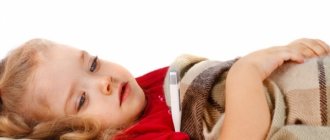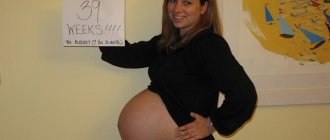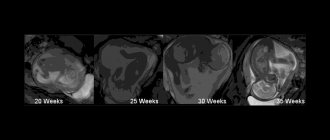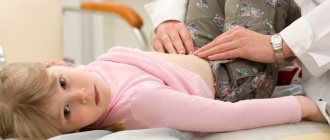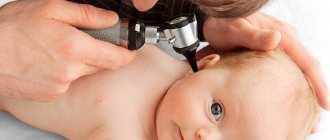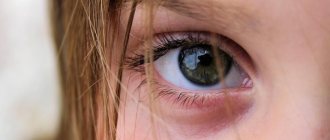Types of pain
A child under two years of age shows pain by crying, refusing to eat, irritability and lethargy. With children over 3 years old, it is easier to diagnose the localization of pain. They can show the problem area on the body and even describe it well.
The nature of pain can be acute or chronic. Abdominal pain in a child occurs for various reasons, depending on which organic and functional pain are classified. Organic pain occurs due to pathology or damage to the gastrointestinal tract. Functional pain bothers a child when the functions of the digestive system are disrupted (colic in infants, intolerance to a certain product, dysbiosis, and others).
Children from one to five years old
Children who have reached the age of two express their suffering by refusing to eat, indifference, nervousness and crying. Those who are three years old can independently, but often incorrectly, indicate the location of pain.
The work of the gastrointestinal tract and internal organs of preschool children is similar to the work of the digestive system of an adult. Therefore, the causes of the disease may be similar. Excluding stones in the kidneys or gall bladder, which are not typical for children.
This type of disease is most often observed in children from eight to fifteen years of age. In a preschooler, the manifestation of the functional type of the disease is almost never encountered, so his complaints about painful sensations are a reason for a visit to the doctor.
In addition to functional pain, there is irritable bowel syndrome, the symptoms of which may include:
- the manifestation of pain is complicated by loose stools or constipation;
- after visiting the toilet (defecation), pain attacks disappear;
- clinical examination excludes the presence of other intestinal diseases.
A separate type of pain manifestations is abdominal migraine, which is expressed in sharp abdominal cramps that develop with age into a regular migraine.
Symptomatically, it is expressed by the fact that for an hour or more, which does not allow him to study and play freely, nausea and headaches occur, reluctance to eat and severe pallor. When waking up after sleep, the spasms disappear.
Functional pain does not pose a serious danger to the child’s life, does not require complex therapy, and disappears with age.
To prevent the disease, you can eat foods containing large amounts of plant fiber, as well as cereals and dried fruits. If the attacks become unbearable, it is necessary to give painkillers (ibuprofen, paracetamol, etc.).
When do you urgently need medical help?
If a small patient has unbearable and cutting pain in the right side of the abdomen, then this may be a sign of inflammation of the gallbladder or biliary tract, as well as hepatic colic. Sharp pain in the abdominal area can be caused by acute appendicitis and pancreatitis, intestinal infection, severe poisoning and intussusception. Clinical picture requiring urgent diagnosis and medical assistance:
- severe abdominal pain;
- nausea and vomiting;
- tension in the abdominal muscles;
- forced position and immobility;
- diarrhea and flatulence;
- tachycardia;
- pallor and general serious condition;
- lethargy or excessive agitation;
- increased or decreased body temperature.
When to see a doctor if a teenager has stomach pain?
In any case, at the slightest complaint of abdominal pain, you need to urgently consult your doctor for a series of examinations and make a correct diagnosis. If a teenager has a stomach ache, the illness can be of a different nature and this issue must be approached carefully in order to avoid more serious illnesses. It is not worth talking about the functional and psychogenic nature of pain until a possible organic cause has been excluded, which may include
- metabolic
- or neurological disorder.
In medical practice, there is such a disease of a teenager as “abdominal form of epilepsy,” which, first of all, causes abdominal pain.
It is very important to avoid performing unnecessary laparotomy in adolescents who have psychogenic abdominal pain, because after laparotomy, adhesions develop in the abdominal cavity, as well as the risk of adhesive intestinal obstruction. A great help for examining adolescents with an atypical history is laparoscopy, which often replaces laparotomy, and provides a great opportunity to prevent surgical intervention
If your child has pain in the lower abdomen, you should not ignore it. However, this is not a disease, but a nonspecific symptom, that is, it can be a sign of a number of diseases. In the pelvic area, there are not many nerve endings, so impulses from them are poorly differentiated in the central nervous system. This means that additional research will be needed to determine the cause of the disease. In addition, you need to consider all the symptoms as a whole. To make a correct diagnosis, you need to know whether the pain is accompanied by nausea and vomiting, whether the child has chills or fever, or whether he suffers from anorexia. In each case, it can hurt differently, so you need to know the localization of pain and its main characteristics (pulling, aching, sharp pain, sudden onset or gradual development, etc.). Only after this the doctor will be able to prescribe treatment.
What should parents do?
While waiting for the emergency doctor, you need to put the little patient to bed and ensure peace.
Abdominal pain should not be treated on your own. There are cases when, under the usual ailment in the abdominal area, pathologies are hidden that require immediate surgical intervention. Parents are prohibited from:
- giving the patient analgesics, antispasmodics, drugs with bacteria, laxatives and any other known medications - this will make it difficult to diagnose the problem;
- warm the tummy with a heating pad, give an enema without a prescription - the inflammatory process can progress and lead to the formation of purulent inflammation (peritonitis);
- give any food and fluids until examined by a doctor - if anesthesia is necessary, if surgery is still required, a full stomach will provoke vomiting;
- press on the painful area or touch it - in the case of acute appendicitis, careless actions can cause the appendix to burst, which is fraught with dangerous health problems.
Acute appendicitis
When sharp abdominal pain appears, acute appendicitis is undoubtedly one of the most serious pathologies. It is extremely rare in infants. The disease mainly develops in children aged 8–14 years, although it also occurs in preschoolers. Doctors consider this disease dangerous in children, since the inflammatory process in them develops much faster than in an adult. This means that the risk of inflammation of the abdominal cavity (peritonitis) in children is much higher. Signs of the disease that should alarm parents:
- A sharp pain begins near the navel, after a few hours pain appears in the right side of the abdomen, then it spreads to the entire abdominal area;
- pain radiates to the legs or arms;
- pallor, constant dry mouth and thirst;
- irritability or lethargy;
- anxiety and pain when changing position, constantly lying only on the right side;
- when touching the stomach, pain appears;
- nausea and vomiting occurred;
- the temperature has increased (maybe normal);
- the stool became liquid.
In cases where parents have detected at least a few of the described symptoms, immediate consultation with a surgeon is necessary. If the suspicion is confirmed, surgery will be required. The younger the children, the more difficult it is to diagnose the disease.
Other reasons why pain may occur
If a child has a stomach ache on the left after or during physical activity, then this condition can be explained as follows:
- When a child plays sports, his blood circulation increases. Gradually, its ligaments warm up and become capable of withstanding heavy loads.
- Lactic acid accumulates in the muscles, which is a by-product of any physiological processes. Under heavy loads, its concentration rapidly increases, which causes pain in the left side.
- Pain syndrome can develop several days after active training. It can be associated with the fact that under heavy loads, muscle fibers rupture and microscopic wounds form.
- In most cases, pain in children appears after playing sports due to the fact that their still unformed body is not able to cope with heavy loads.
- To prevent discomfort, it is necessary to gradually accustom the body to exercise. You need to start with regular exercises, which involve simple exercises.
- When playing sports, children should monitor the depth and frequency of their breathing. If they can ensure proper oxygen supply, both during and after exercise, they will minimize the possibility of discomfort.
- Before physical activity, you should not eat food, especially heavy food, as it can cause stomach discomfort.
- If pain after physical activity does not lose its intensity after a few days, then it is necessary to consult with specialists, as they may signal the development of a disease.
Poisoning
Children can be poisoned by low-quality products, toxic substances or pills that they take into their mouths from an attractive jar.
They have a poorly developed gag reflex, and due to their low body weight, rapid dehydration occurs - this poses a threat to the life of a small patient. This is why poisoning in children is much more serious than in adults. The symptoms and course of the disease depend on the amount of toxic substances or poor-quality products that enter the gastrointestinal tract (GIT). Clinical picture of poisoning:
- colic and abdominal pain;
- the temperature is usually elevated;
- diarrhea;
- nausea accompanied by vomiting;
- cyanosis of the skin;
- increased salivation;
- drop in blood pressure.
Symptoms of the disease appear 1-2 hours after toxins or pathogens enter the gastrointestinal tract. Poisoning in childhood is accompanied by rapid dehydration, which can cause renal and heart failure, central nervous system dysfunction, hypovolemic shock and even coma. Parents of a small patient should urgently call a doctor.
Causes of pain in the abdomen
There are several main reasons that cause a baby to have pain in the lower abdomen. It is worth considering them in more detail:
Food poisoning
If the pain is associated with food poisoning, then the symptoms here will be specific:
- nausea;
- vomiting reflex;
- spasms and colic;
- diarrhea;
- the stomach hurts in the lower or central part;
- the temperature rises.
Most often, poisoning occurs as a result of eating stale food.
But if we talk about newborns, a similar problem occurs when a woman who is breastfeeding does not adhere to a diet and eats foods that are too “heavy” for the baby’s gastrointestinal tract.
When pain is observed in the lower or left abdomen, you need to immediately rinse the stomach. Specialists working in the ambulance team are able to do this quickly and professionally.
But if it is not possible to wait for doctors, then rinsing can be done at home, using baking soda or a solution of potassium permanganate.
Dyspepsia and colic
Everyone knows that babies often experience colic due to an incomplete digestive tract. But even in older children, sometimes there is a lack of enzyme in the intestines, manifested by digestive disorders.
This pathology is called dyspeptic disorder and often provokes pain in the lower abdomen.
But the problem also has other symptoms:
- diarrhea after eating;
- spontaneous nausea, vomiting, independent of food intake;
- pain in the abdomen below, in the center or on the sides.
Most often, colic occurs in children under six months of age, who cannot tell what and where it hurts, so they simply react to the problem by crying.
Diagnosis of the pathological condition in question must be carried out by a qualified specialist.
It is appropriate to carry out complex therapy aimed at restoring the microflora in the intestines and producing the required amount of enzymes in it.
Appendicitis is a pathology that is considered the most dangerous for a child. Diagnosis of acute appendicitis is not easy, because the disease is easily confused with other diseases, from gynecological to urological.
Doctors always take into account children’s complaints, the duration of pain and their location. Like other inflammatory pathologies, appendicitis provokes fever and chills
Like other inflammatory pathologies, appendicitis provokes fever and chills.
Parents should know that if such symptoms are present, it is strictly forbidden to apply a heating pad or woolen blanket to the child’s stomach.
In addition, you should not give your child painkillers until doctors arrive.
Tablets can temporarily relieve pain and make the situation even worse, because the symptoms will be washed away, so the doctor will not be able to diagnose the true problem in a timely manner.
If a child’s pain in the lower abdomen increases, profuse sweating appears, and the skin turns pale, you need to urgently call an ambulance and transport the baby to the hospital emergency department.
It is prohibited to attempt treatment at home, because this will not lead to a positive result, but will only take away precious time.
Parents must know their children well in order to promptly identify the symptoms of appendicitis. Many children are afraid of doctors, so they often hide pain until it becomes unbearable.
Intestinal obstruction
A pathology in which some segment of the intestine folds into itself is intussusception (intestinal obstruction). The blood circulation of the intestinal wall is disrupted, swelling appears, which causes acute pain in the abdomen. In boys, the disease is more common, with the main percentage of patients aged between six months and 2 years. The pathology develops suddenly and is accompanied by the following symptoms:
- fussiness and irritability;
- bloating of the abdomen; upon palpation, a small formation is felt in its upper half;
- vomit;
- acute abdominal pain, appearing every 5-30 minutes;
- diarrhea, presence of mucus and blood in the stool.
For intestinal obstruction, surgical treatment and enemas are prescribed. Failure to consult a doctor in a timely manner can result in dangerous situations: infection of the peritoneum or perforation in the intestinal wall.
Why does my left side hurt?
Learn about the main causes of left side discomfort in this article.
Who among us hasn’t had children complain about pain in their side after attending physical education classes? We are confident that more than half of the readers will answer this question positively. Some people have pain under the ribs on the left side from intense jumping rope, others have severe stabbing pains in the back after running around the school stadium.
However, first we want to warn you that this article is intended to help you understand the main causes and symptoms and is not a guide to self-medication. Contact your doctor and he will definitely find out the cause of the pain and the disease associated with it. You will certainly be prescribed effective treatment. A good place to start is with a therapist, and in some cases this may be a chiropractor.
Why does my left side hurt? And what to do about it? Let's find out!
During the puberty period, any significance is rarely attached to certain disruptions in the body, even if they cause pain. Life is in full swing and the child (teenager) simply does not find time to analyze the causes of pain in the left side. However, their parents should not show the same carelessness. Children tend to believe that all “sores” will go away on their own, but parents need to remember:
The reason for the occurrence of unpleasant periodic pain may lie in the beginning or, conversely, a progressive disease of the internal organs located on the left side of the human body. Let's remember our anatomy lessons and name all the organs on the left:
- Half a heart
- Left side of the lung
- Left kidney
- Spleen
- Pancreas
- Stomach (partially)
- Intestines (also partially)
- Ureter
In addition, in girls, pain in the left side can be a sign of an ectopic pregnancy, when the embryo attaches not in the uterus, but in the fallopian tubes. Pain can also occur in very young girls, as a result of an inflammatory process in the left ovary or fallopian tube. In this case, most likely, you will have to take antibiotics, which will be prescribed by a doctor at the antenatal clinic at your place of residence or in another private medical institution. An accurate diagnosis can only be made by a qualified specialist - a doctor. We can only preliminarily determine the nature of the pain and associate it based on specific characteristics with any organ.
How to do this at home, so to speak, “without taking off your slippers”? To do this, you need a good imagination to mentally divide the body from the chest to the hip into 4 conventional square parts. At the first attack of pain, determine where and what hurts you: the left side of your back, lower abdomen or back in the lower back? Maybe, on the contrary, strong stabbing sensations are localized in the upper left?
The upper left part is characterized by diseases of the heart, spleen and gastrointestinal tract. Often in adolescents, pain in the left epigastric region is associated with pancreatic hyperactivity.
If the pain is dull and accompanied by an increase in temperature, then the causes may lie in the lungs. It is possible that the child (or adult) has left-sided pneumonia. In this case, immediate hospitalization and subsequent treatment in a hospital are required. If we are talking about a sudden onset of acute pain in the left hypochondrium of a cutting nature, preceded by a fall from a height greater than one’s own height, then, most likely, a rupture of the spleen is stated here.
The lower left part of the body is characterized by pain due to problems with the intestines, with the female genital area, including infectious diseases and concomitant inflammatory processes.
Why does the left side of the fair sex hurt? In addition to the above cases, to the problem of the female body, accompanied by pain in the left side, it is necessary to add disorders associated with reproduction and the menstrual cycle. If the cycle stops completely, is accompanied by pain in the lower abdomen, but there is no pregnancy, a mandatory examination for a malignant tumor is required. The latter case is extremely undesirable and is accompanied by immediate hospitalization and all procedures necessary for a complete recovery.
Summarizing the above, we note once again that any pain in the left side is not accidental. Their sources may be diseases that should not be left to chance. Remember, even if you find out (approximately) what hurts you, do not rush to diagnose yourself - this is the prerogative of an experienced specialist.
Figuratively speaking, a sore noticed in time and lubricated with brilliant green will never lead to amputation... Be healthy!
No comments yet!
Intestinal parasites
Worms can cause pain in children. They enter children's bodies through poor hygiene, contact with sick animals, contaminated meat, and poorly washed fruits and vegetables.
Painful sensations come in attacks. The child sleeps poorly at night, grinds his teeth, and sharp pains in the abdomen make him cry out in his sleep. At the initial stage, a sick person feels unwell: weakness, nausea, vomiting. The patient loses weight even if he eats well. Constipation may be replaced by diarrhea, and bouts of vomiting are possible - these are symptoms of infection with roundworms, pinworms and tapeworms. If there is no treatment, the number of parasites increases. They irritate the mucous membrane, which causes excessive gas formation and severe bloating. Parasites can be found in the patient's stool. They can also be easily identified by examining blood, stool and urine. The entire family of the patient is subject to preventive treatment.
Inflammatory processes in the gallbladder and biliary tract
When children complain of pain in the right side of the abdomen, it is usually a sign of cholecystitis (inflammation of the gallbladder), angiocholitis (inflammatory process in the bile ducts) or dyskinesia (impaired functionality). In addition, the little patient experiences the following symptoms: headache, pallor, decreased appetite, nausea, bitterness and dry mouth. In most cases, the disease progresses gradually. Exacerbation can be caused by sweet, overcooked or fatty foods. The nature of the pain can be either dull or severe, radiating to the area of the right shoulder. The stool is characterized by a light clay color. There is constipation or diarrhea. In case of serious exacerbation, treatment takes place in a hospital. The patient is prescribed duodenal drainage without a probe, bed rest and diet.
Physiological pain
Acute pain often occurs after physical exercise. Especially if the child is not physically prepared in advance. During exercise, blood circulation and energy production are accelerated. Because of this, the body temperature rises. Over time, the baby's muscles and ligaments become stronger, and he tolerates physical activity more easily.
At this moment, two types of painful sensations arise - immediate and delayed. Let's look at them in more detail:
- Immediate pain in the lower abdomen is caused by lactic acid produced during increased physical activity. It is a negative consequence of increased physical activity. When playing sports, the amount of the substance increases, which provokes severe painful discomfort on the left side in a boy or girl. At the same time, this kind of symptom can signal the development of pathology of the genitourinary system. Therefore, there is a need to consult a doctor.
- Delayed pain appears after 2-3 days. It occurs when the load increases, or if the child has had a break from sports for a couple of days. Small wounds or tears in muscle fibers cause similar sensations. But the body can react in this way due to the onset of the inflammatory process. In this case, it would also be a good idea to check with a pediatrician.
Only the attending physician can accurately diagnose the disease after examining the child, determining the location of the manifestation and the factors that provoke it. Sensations may first appear in the navel area, then radiate to the left. This indicates gastrointestinal problems and urological diseases. This also includes diseases of the musculoskeletal system. Here the reason lies in the not yet fully formed growing organism, which is not yet able to cope with the physical activity required of the baby.
When doing physical exercise, painful sensations are sometimes not dangerous. But you still need to play it safe and show the baby to the doctor. After all, when the abdominal muscles, as a result of the load, begin to put pressure on the inflamed organ, pain occurs. Therefore, in case of prolonged discomfort, you need to undergo a full examination so as not to start a developing disease.
Painful sensations in girls over eleven
If a teenage girl complains of acute pain and cramps in the lower abdomen, then this is the body’s preparation for approaching menstruation. The discomfort can be aching or pulling. Girls are able to feel the movement of a blood clot through the pharynx and vagina, especially if they are virgins. Sometimes such a movement can cause acute pain in the lower abdomen as a result of the fact that it is difficult for the clot to penetrate through the hymen.
When the discomfort is severe and does not go away for a long period of time, it is worth visiting a gynecologist. After all, this may indicate problems in the reproductive system or the opening of hemorrhage.
Why does it hurt in the lower abdomen?
Pain in the lower abdomen can cause problems with the functionality of the pelvic organs or inflammatory processes in them. For example, they may indicate problems with the kidneys or bladder. Diagnosis of the pathology is made based on the accompanying symptoms and the nature of the pain in the lower abdomen. Reasons that can become a source of pain in the lower abdomen in children: cystitis, intestinal colic, intestinal dysbiosis, consequences of acute respiratory viral infections or infectious diseases, and in some cases appendicitis.
Main reasons
Abdominal pain can be acute, chronic or recurrent. They can be accompanied by a considerable number of different diseases.
Acute pain occurs due to injury, infectious disease, food poisoning, and acute surgical diseases.
Girls mainly complain of recurrent pain.
Important! 10% of school-age children periodically experience abdominal pain associated with psychological factors (stress, anxiety, nervous fatigue). Children may experience a dull pain at the navel, nausea, headache, drowsiness, nervous tics, etc.
It is imperative to talk with the child, meet with his teacher or educator to identify the causes of psychological discomfort.
There are a large number of reasons for the appearance of abdominal pain in girls, among them the following are distinguished:
- Constipation, poor digestion, stomach upset.
- Chronic diseases of the digestive organs, such as gastritis, gastroduodenitis, pancreatitis and others.
- Inflammation of internal organs, genitourinary system, inflammation in the intestines.
- Crick.
- Flu, cold.
- The reasons are psychological, stress, nervous overstrain, panic attacks.
- Problems with blood circulation.
- Spasms of the abdominal organs.
- Eating foods that are incompatible with each other.
- In girls aged eight to sixteen years, abdominal pain often indicates an attack of acute appendicitis. This is one of the most dangerous situations for girls aged 9 and 10 years. After some time, the pain moves to the right side, after which other signs of this disease begin to appear - the temperature rises, nausea and vomiting, diarrhea, pain in the muscles appear. The same symptoms can sometimes indicate inflammation of any intestine.
- Also at this age, if a girl’s lower abdomen hurts, this indicates that menstruation has begun. Cramping pain sometimes radiates to the lumbar, femoral region and the area of the external genitalia. Pain can occur either during menstruation itself, or several days before it begins.
- Acute pain in the lower abdomen may occur due to ovarian rupture. They are usually observed in the middle of the menstrual cycle or after a short delay. The pain may radiate to the lower back or umbilical region.
- In addition, the cause of pain is often salpingitis (a disease in which the fallopian tubes become inflamed). The presence of a chronic form of the disease is indicated primarily by dull, constant pain in the lower abdomen, which intensifies when urinating or during sexual intercourse. In the acute form of the disease, the pain is sharp and burning and radiates to the rectum.
- In girls aged 1 to 8 years, abdominal pain is usually due to indigestion or a reaction to a certain food. Here it is necessary to cleanse the intestines. There is also an intolerance to certain foods; in this case, you need to determine which food should be excluded from the diet and replaced with one similar in composition.
- The most common cause in infants is colic. They occur in more than seventy percent of newborns. But fortunately, this is a temporary problem, and it usually goes away within six months.
Important! Often the cause of chronic abdominal pain in children is the presence of worms. Children are worried about bloating, headache, increased salivation, loss of appetite, etc.
symptoms. It is necessary to take a stool and blood test.
Colic
In infants up to six months of age, colic is a fairly common occurrence. They occur in healthy babies when they swallow air during breastfeeding or intolerance to lactose contained in human milk. The cause of colic in a baby may be the nursing mother's consumption of foods that cause gas formation, or the transition to artificial nutrition. Colic can be recognized by the following symptoms:
- the pain is unstable - it subsides with the release of gases;
- the baby cries loudly;
- The baby twitches his legs and presses them to his tummy.
As a rule, by the fifth month everything goes away without intervention. You can alleviate the baby’s condition with a warm diaper, special medications and clockwise stroking of the tummy, aimed at improving bowel function. In older children, colic is rare, mainly in those who consume sweets excessively.
Dysbacteriosis in children
After infectious diseases, poisoning, a course of antibiotics, poor nutrition, and nervous stress in young children, an imbalance of microflora occurs, in which pathogenic microorganisms predominate in the intestines. Dysbacteriosis causes abdominal pain. Symptoms of microflora imbalance: diarrhea, constipation, severe gas formation, bad breath, fatigue, poor sleep. In infants, the disease causes immaturity of the digestive system. The following pathologies can also cause the painful condition: rickets, anemia, artificial feeding. Children with this problem eat poorly and gain weight slowly. Allergic reactions are possible.
Cystitis
According to statistics, the disease occurs more often in female children. This is due to the difference in the physiological structure of the genitourinary system in girls and boys. The disease occurs when a bacterial infection enters the bladder. Quite often, cystitis develops when a child’s body is hypothermic. Pain in the lower abdomen in a child is accompanied by a constant urge to urinate. A small patient often goes to the toilet, and the urine is cloudy or mixed with blood. The disease occurs in chronic or acute form. An exacerbation of the disease appears suddenly and is accompanied by pronounced symptoms and pain. The chronic form occurs when the disease recurs several times. The pain may come and go for a while.
Abdominal pain in boys
While women develop gynecological pathologies from a very young age, boys are more likely to develop intestinal problems.
But we should not exclude the occurrence of cystitis and even prostatitis, which, without proper treatment, becomes chronic.
That is why, at the first alarming symptoms, you should take the child to a urologist, who will examine him, prescribe the necessary examination and prescribe adequate treatment.
The sooner the parents go to the hospital, the fewer complications their son will develop in the future.
In both girls and boys of different years, pathologies of the reproductive system can be accompanied not only by pain in the abdominal area, but also by bleeding of various types.
If fever is added to these symptoms, the doctor may suspect gonorrhea. Alas, this disease occurs even in infants infected from their mother.
The risk of developing mycoplasmosis, a disease associated with a child’s reduced immunity, should not be excluded. But this problem is quite rare.
Constipation
If a child does not have a bowel movement for two days, this condition is called constipation. It causes discomfort and pain in the intestines. Feces are dense and dry, defecation is difficult. Children suffering from constipation have poor appetite, unpleasant taste in the mouth, increased gas production and a sallow complexion.
In children, the frequency of bowel movements is determined by diet and lifestyle. The problem usually occurs when there is a lack of fiber in the diet. Retention of bowel movements in childhood can be caused by shyness, bashfulness or lack of time to go to the toilet, for example, in the morning before school. Proper nutrition and teaching children to defecate at regular times every day often helps solve the problem.
Causes of chronic pain
Pain that lasts more than three months is called chronic. They are the most difficult to diagnose and are considered a treatment problem in pediatrics. In medical practice, the most common occurrence is recurrent abdominal pain in a child - they are repeated more than three times in 3 months and interfere with the child’s normal active life. In this case, to identify potential causes, some experts suggest parents keep a diary for two weeks, recording symptoms, food consumed and medications taken. Chronic pain is caused by the following abdominal diseases: ulcers, gastritis, gastroduodenitis, duodenitis.
The child complains of pain in the right side of the abdomen
A common cause of concern for parents and their visits to a pediatrician is the child’s complaint of pain in the right side under the ribs.
This symptom can accompany the development of various diseases affecting both the digestive tract and other body systems.
Therefore, if persistent and frequent pain in this localization occurs, you should immediately contact a specialist for examination and clarification of the diagnosis with the obligatory determination of the cause of the pain syndrome.
The pain, which is localized in the right side under the ribs, can have a different nature, duration and combination of associated symptoms for different diseases.
In some cases, the localization of pain corresponds to the immediate location of the affected organ:
- liver;
- gallbladder;
- stomach;
- diaphragm;
- lower parts of the lungs;
- abnormally located kidneys or appendix.
A separate category includes “referred” pain in the right side under the ribs, which can occur:
- with damage to the pancreas (girdling pain radiating to the right hypochondrium);
- diseases of the duodenum;
- with intestinal inflammation (enteritis and enterocolitis);
- for right-sided gynecological diseases (adnexitis, cystic diseases).
The acute nature of the pain is more characteristic of an active inflammatory process, which requires immediate diagnosis
When the pain is aching, not only a subacute or chronic inflammatory process is more often diagnosed, but also functional disorders of the affected organ.
Right lower lobe pneumonia and/or pleurisy
Inflammation of the lungs in the lower parts on the right is often manifested by aching pain in the right hypochondrium at the site of projection of the affected lower lobe.
In this case, the pain syndrome is accompanied by an acute onset of the disease with high fever with malaise, weakness and sweating, which is combined with cough and shortness of breath. Most often this pathology occurs in children.
Right-sided diaphragmatic pleurisy (inflammation of the pleural layers that surround the right lung) may be accompanied by:
- stabbing or aching pain in the right hypochondrium;
- dry irritating painful cough;
- severe painful hiccups;
- increased body temperature;
- pain when swallowing.
The patient’s forced position is also typical – sitting, leaning forward.
Helminthiasis
Most often, helminthiasis develops in childhood.
The main diseases are ascariasis (infection of the intestines by roundworms), giardiasis (infection by Giardia) and enterobiasis (infection by pinworms).
These diseases are accompanied by:
- the appearance of pain in the right side under the ribs or in the umbilical area;
- sleep disorders;
- decreased appetite;
- itching of the perianal area;
- skin rash;
- grinding teeth.
With giardiasis, blockage of the bile ducts by Giardia may occur and jaundice, arthralgia, skin rash, discoloration of urine and discoloration of feces may develop.
doctor - pediatrician Sazonova Olga Ivanovna
source
Abdominal pain in a child. Pain in the right side of the abdomen
Abdominal pain in a child is one of the most common complaints mothers face. They occur both in infancy and in preschool or school age.
The reasons causing this trouble may be different.
How to understand why exactly your stomach hurts? To do this, you need to understand the nature of pain and the symptoms that accompany them - this will help to distinguish a serious illness and navigate correctly.
Source: https://sfmggu.ru/rebenok-zhaluetsya-na-bol-v-pravom-boku-zhivota/
Diseases of the duodenum and stomach
Chronic gastritis, gastroduodenitis, duodenitis are long-term diseases that cause inflammatory processes in the mucous membrane of the stomach and duodenum. Diseases have moments of subsidence and exacerbation. Abdominal pain in a child is localized near the navel. They vary in strength and duration, as a rule, appear after eating and are accompanied by sour belching.
Diseases are caused by improper dry diet, excessive presence of spicy foods in the diet, certain medications, and the bacterium Helicobacter pylori (H. pylori). If this infection is not treated, gastritis can lead to peptic ulcers.
With an ulcer, pain occurs on an empty stomach or at night. In addition, the little patient feels nausea in the morning and sometimes complains of heartburn, bitterness and belching. A white coating appears on his tongue, and he may have bad breath. The child has a tendency to constipation and gas formation.
How is the treatment carried out?
After identifying the causes of pain, a highly specialized specialist will select a course of drug therapy for the young patient.
Depending on the severity of the disease, the following treatment may be prescribed:
- medications;
- massage;
- physiotherapeutic procedures;
- physiotherapy;
- surgical intervention;
- chemotherapy, etc.
If the doctor does not object, then mothers can, in parallel with the prescribed course of treatment, use safe “old-fashioned” methods to eliminate pain:
- for gastritis, you can give children peeled and finely chopped apples (green);
- for diseases of the genitourinary system, it is recommended to give children herbal decoctions or special herbal teas;
- for heart disease, young patients are recommended to drink a decoction made from valerian, rosemary, and yarrow;
- for pathologies of the spleen, propolis tincture, etc. should be used.
Psychological pain
Sometimes children experience pain of a psychogenic nature in the abdomen. Their cause may be stressful situations, the desire to attract the attention of adults, or the use of pain to achieve a goal. Painful attacks arise and disappear spontaneously. Between them, the children feel great. A quarrel in the family, troubles with friends, reluctance to go to school - all this can cause a new attack of pain. Emotional children are susceptible to this condition. The discomfort can be managed by helping them solve problems and cope with the source of their anxiety. You can seek advice from a child psychiatrist.
Pain in the right side under the ribs in a child - why does this symptom occur?
A common cause of concern for parents and their visits to a pediatrician is the child’s complaint of pain in the right side under the ribs.
This symptom can accompany the development of various diseases affecting both the digestive tract and other body systems.
Therefore, if persistent and frequent pain in this localization occurs, you should immediately contact a specialist for examination and clarification of the diagnosis with the obligatory determination of the cause of the pain syndrome.
The pain, which is localized in the right side under the ribs, can have a different nature, duration and combination of associated symptoms for different diseases.
In some cases, the localization of pain corresponds to the immediate location of the affected organ:
- liver;
- gallbladder;
- stomach;
- diaphragm;
- lower parts of the lungs;
- abnormally located kidneys or appendix.
A separate category includes “referred” pain in the right side under the ribs, which can occur:
- with damage to the pancreas (girdling pain radiating to the right hypochondrium);
- diseases of the duodenum;
- with intestinal inflammation (enteritis and enterocolitis);
- for right-sided gynecological diseases (adnexitis, cystic diseases).
The acute nature of the pain is more characteristic of an active inflammatory process, which requires immediate diagnosis
When the pain is aching, not only a subacute or chronic inflammatory process is more often diagnosed, but also functional disorders of the affected organ.
Diseases of the right kidney
Dull, aching pain in the right side under the ribs may be a symptom of diseases of the right kidney if it is abnormally high.
Referred pain is also possible:
- with severe inflammatory diseases of the right kidney (pyelonephritis, glomerulonephritis);
- hereditary or dysmetabolic nephropathies.
Dysmetabolic nephropathies
Today they are often found in pediatric practice and are characterized by frequent migrating abdominal pain, quite often localized in the right hypochondrium.
This disease develops as a result of severe metabolic disorders with damage to the interstitial tissue of the kidneys and salt deposition.
In addition, the pathology is often combined with biliary dyskinesia.
Therefore, pain is localized mainly in the right hypochondrium with irradiation to the lower abdomen, periumbilical region and lower back.
Pain syndrome is accompanied by:
- weakness;
- lethargy;
- malaise;
- pale skin;
- recurrent joint pain (often at night);
- dysuric disorders (pain and burning during urination, development of enuresis in children and nocturia);
- headaches;
- persistent loss of appetite.
Often, against the background of dysmetabolic nephropathies, inflammatory diseases of the right kidney develop:
- nephritis of various etiologies (pyelonephritis, glomerulonephritis);
- urinary tract infections;
- cystitis.
When aching pain appears in the right hypochondrium, which is combined:
- with urinary disorders;
- with general symptoms;
- with the presence of salts in the urine (sediment after prolonged standing or unpleasant odor of urine).
It is necessary to consult a doctor (pediatrician, urologist or nephrologist) to clarify the diagnosis and additional examination (general urinalysis, ultrasound of the kidneys).
Pancreatic diseases
Chronic inflammation of the head of the pancreas is characterized by the appearance of pain in the right hypochondrium with periodic attacks of girdle pain, especially with errors in diet.
They are accompanied by severe nausea and vomiting, which does not bring relief. Also observed:
- weakness;
- heaviness in the epigastric region;
- persistent loss of appetite;
- belching;
- rumbling and bloating;
- flatulence;
- sweating;
- a sharp decrease or increase in body temperature;
- brittle nails and hair;
- “jams” in the area of the corners of the lips;
- change in urine color;
- skin itching.
Right lower lobe pneumonia and/or pleurisy
Inflammation of the lungs in the lower parts on the right is often manifested by aching pain in the right hypochondrium at the site of projection of the affected lower lobe.
In this case, the pain syndrome is accompanied by an acute onset of the disease with high fever with malaise, weakness and sweating, which is combined with cough and shortness of breath. Most often this pathology occurs in children.
Right-sided diaphragmatic pleurisy (inflammation of the pleural layers that surround the right lung) may be accompanied by:
- stabbing or aching pain in the right hypochondrium;
- dry irritating painful cough;
- severe painful hiccups;
- increased body temperature;
- pain when swallowing.
The patient’s forced position is also typical – sitting, leaning forward.
Helminthiasis
Most often, helminthiasis develops in childhood.
The main diseases are ascariasis (infection of the intestines with roundworms), giardiasis (infection with Giardia) and enterobiasis (infection with pinworms).
These diseases are accompanied by:
- the appearance of pain in the right side under the ribs or in the umbilical area;
- sleep disorders;
- decreased appetite;
- itching of the perianal area;
- skin rash;
- grinding teeth.
With giardiasis, blockage of the bile ducts by Giardia may occur and jaundice, arthralgia, skin rash, discoloration of urine and discoloration of feces may develop.
doctor – pediatrician Sazonova Olga Ivanovna
Source: https://zen.yandex.ru/media/mirmam/bol-v-pravom-boku-pod-rebrami-u-rebenka—pochemu-voznikaet-etot-simptom-5d974795b477bf00ade351e7
